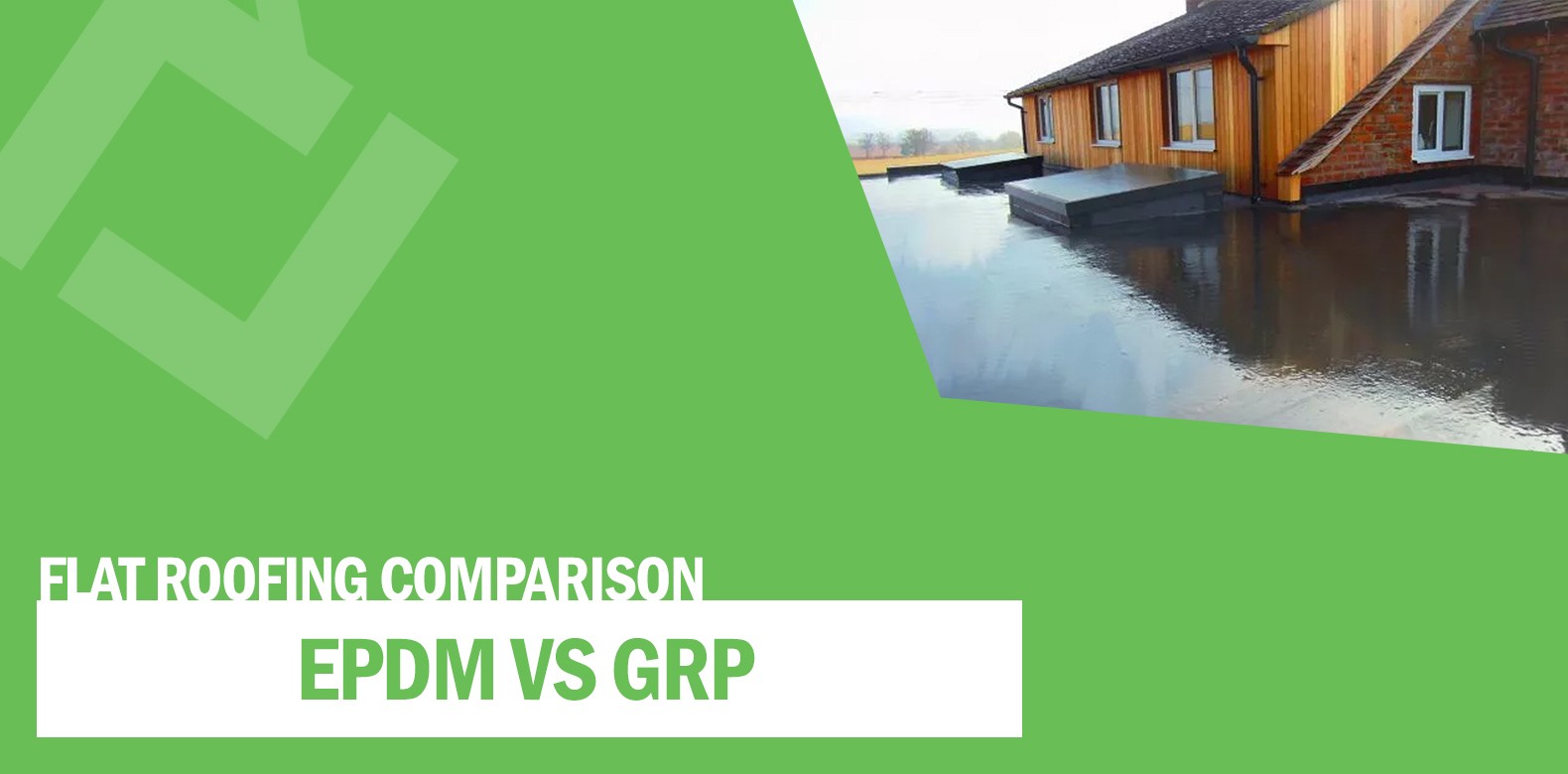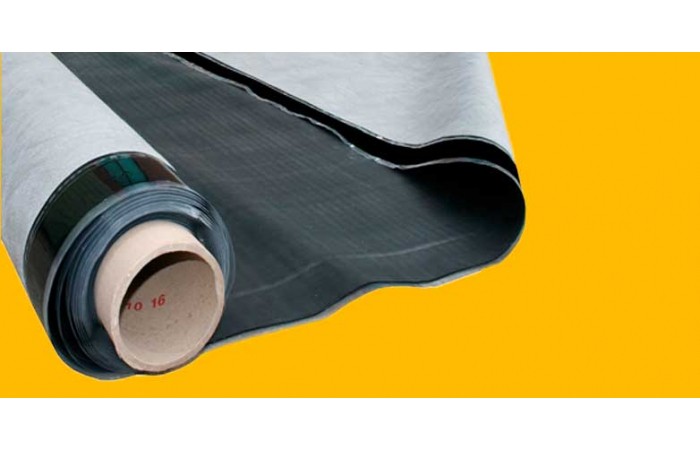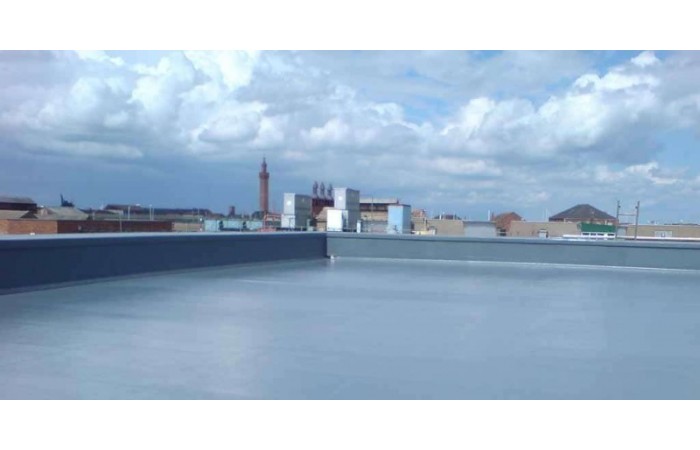EPDM vs GRP Flat Roofing

With more affordable costs, quick and easier installation methods, plus more reliable durability, flat roofing is becoming progressively more popular with small structured builds as well as some larger commercial buildings. EPDM and GRP roofing serve as two of the most practical and commonly used flat roofing materials, so the question is, which one should you choose for your flat roof? A good place to start is fully understanding what each kind of roofing actually is.
Table of Contents
What is EPDM Roofing?
EPDM stands for ethylene propylene diene monomer. Its two main ingredients, ethylene and propylene are derived from natural gas and oil, ensuring heat and weather resistance which makes it perfect for flat roofing installation. EPDM is a synthetic rubber that stands with one of the highest durability levels for flat roofing with an impressive lifespan that requires low maintenance.
What is GRP Roofing?
GRP stands for glass reinforced plastic. GRP roofing is also known as fibreglass roofing and is a material made from polyester resin which is reinforced by chopped strand mat glass fibres, forming a GRP laminate. It offers robust strength and great durability but is also very lightweight and flexible as well as being waterproof.
A Comparison of EPDM and GRP
Material Quality
EPDM – Brilliantly robust yet highly flexible, EPDM is a rubber-like material that is ideal for roofs with uneven surfaces. It is a breathable material, but also impermeable which means it allows moisture and heat to escape from the roof space without letting moisture, smoke and vapours can enter it. A disadvantage, however, is that shrinkages with this material can happen.
GRP – GRP is flexible and very lightweight so can be installed on roofs where other materials may be too heavy. It also works effectively on green roofs and more complex roof shapes. Fibreglass sets a jointless, tightly bonded finish that makes sure your roof stays completely sealed, allowing no moisture to move in underneath.
Durability & Lifespan
EPDM – With correct installation, EPDM is a much longer-lasting than other types of roofing. EPDM offers an average lifespan of 25-30 years but has been known to last as long of 50 years with the right care and maintenance. Even in harsher conditions, this rubber-like material is extremely durable plus has elasticity which means that contraction, expansion, and thermal movement will not cause blistering, cracking, and rot.
Although highly robust, EPDM is not completely indestructible as with heavy foot traffic and large falling objects such as tree branches, there is a possibility of the membrane tearing.
GRP – GRP roofing also offers fantastic durability with an average lifespan of at least 25-30 years if fitted correctly. Although lightweight, GRP offers an excellent strength-to-weight load-bearing performance and can easily withstand harsh conditions with very minimal wear and tear or pressure. GRP is resilient against the growth of moss plus highly resistant to corrosion.
Weather Resistance
EPDM – EPDM is highly waterproof and seam-free which means it is much less likely to cause leakages. Plus, with special resistance to salt water, it is the perfect flat roofing choice for coastal properties. EPDM also offers fantastic UV resistance and copes well with expansion and contraction which is caused by the sun heating your roofing then cooling at night.
GRP – GRP is also extremely waterproof and highly practical in wet, stormy weather. When correctly installed, it is completely leak-proof and watertight so even the heaviest downpours won’t be a problem. The fully bonded structure and seamless fabrication allow no moisture penetration.
GRP roofs are also unaffected by UV but some fading can occur over a timeframe of a few years.
Installation
EPDM – EPDM is relatively quick and simple to install for those who understand fully how to do it. It offers flame-free application and is applied as a single sheet glued to a roof decking using a wet bonding adhesive. Trims are then fitted to the roof to create a durable and clean finish. Although straightforward, problems can arise when fitted incorrectly so it is essential that EPDM is only applied by those who are fully confident in the process. EPDM is seen as the more popular choice in terms of application as it offers ease of use.
GRP – GRP is also fairly straightforward to install by someone that knows what they are doing. Firstly, you add a layer of resin, followed by a mat of fibreglass strands and then a second layer of the resin. A protective topcoat is then applied to add weatherproof durability.
Due to the method, GRP roofing can take longer to apply plus cannot be applied in wet conditions so finding the ideal time to install can sometimes be inconvenient. It also is not the best roofing option for larger roof areas as expansion rates can be excessive.
Maintenance & Repairs
EPDM – EPDM roofing generally requires only minimal and occasional maintenance to sustain its high level of quality. Any small tears or holes can be easily repaired by applying a sealant to the damaged area or applying a patch, leaving virtually no sign of damage behind. EPDM roofing is also simple to clean by sweeping off any debris then using a rubber roof cleaner and mopping the roof area.
GRP – Due to its high durability, GRP roofing will not require constant fixing and repairs. Although less likely to break, fibreglass may sometimes be more difficult than EPDM to repair if needed due to the material. GRP can be patch repaired by sanding down and installing a fibreglass patch then topping with a resin and topcoat. Repair sealant can also be used for cracks and gaps in the GRP roofing. Cleaning is quick and simple by clearing any debris and using a long-handled mop with warm soapy water. You can also use a pressure washer for an even easier clean.
Appearance
EPDM – EPDM is definitely popular because of its practical purposes over its visual appeal. It offers quite a simplistic and basic appearance, essentially resembling a large piece of dark rubber on your flat roof. Some may not like the aesthetic it offers if they want a more individual look for their home, although many also do not mind the simple appearance as it is easy to maintain plus is not visible from the ground.
GRP – GRP roofing also appears quite simplistic which may not be ideal for some but it does create a professional, clean looking finish that is completely seamless. Fibreglass roofing is also available in a selection of different colours to give your home more individuality.
Sustainability
EPDM – EPDM is generally seen as a very eco-friendly roofing choice as it is developed using completely recycled rubber. Due to its long lifespan, it does not need constant replacement of materials plus EPDM is compatible for use with a ‘green roof’ which allows vegetation and plants to grow on top to further benefit the environment and natural wildlife.
EPDM rubber also does not pollute the rainwater, meaning no harm to wildlife as well as making it suitable for ‘rainwater harvesting’ which is a fantastic method of more sustainable living. EPDM additionally contains no bitumen, has a low smog impact and is suitable for use with solar panels which are easily installable on EPDM roofing.
GRP – GRP offers a very good environmental profile which much less energy used in production in comparison to other roofing materials. GRP roofs do not emit substances that are harmful to the environment or form any other by-products that could be toxic so are safe to use in grey water systems. GRP is also extremely durable so constant replacement is not necessary meaning less wastage and environmental cost.
Fibreglass can additionally be utilised to create a ‘green roof’ which is a fantastic environmental choice with vegetation and wildlife thriving on top of it. At the end of its lifespan, GRP can be broken down to the composite materials which can in turn be recycled into new materials.
Cost
EPDM – As EPDM is made using recycled materials, it is generally a pretty affordable roofing type. Although more expensive than felt flat roofs for example, EPDM roofing is durable and long-lasting so once installed, will not require regular replacement and maintenance bringing down the overall costs further. The installation process is also pretty straightforward and utilises fewer complex tools so labour costs will also generally be less.
GRP - GRP roofing is typically more expensive than EPDM and other roofing materials but this is because of its premium quality and impressive lifespan. The installation process requires more time, tools and products which can increase the costs considerably however due to its robust durability, need of repairs is less likely meaning less potential spending in the long-run.
EPDM vs GRP Summary
Here is a summary of the main pros and cons of both EPDM and GRP roofing to help you reflect on the points mentioned.
EPDM Roofing
|
Advantages |
Disadvantages |
|
Good durability |
Can be problematic with incorrect installation |
|
Impermeable & waterproof |
Dull & basic appearance |
|
Generally straightforward installation |
Possible shrinkage |
|
Long lifespan of 25-30 years (can reach up to 50) |
Can be fragile in the wrong environment |
|
Weatherproof & UV resistant |
Not indestructible – damage can occur |
|
Ideal for coastal builds |
|
|
Very environmentally friendly |
|
|
Generally affordable & cost-effective |
|
|
Minimal maintenance & easy repairs |
|
GRP Roofing
|
Advantages |
Disadvantages |
|
Lightweight & flexible |
Not well suited to large roofs – high expansion rates |
|
Highly robust & durable |
Only installable in dry conditions |
|
Enhanced lifespan of 25-30 years |
More expensive |
|
Weatherproof & leakproof |
UV can cause fading over the years |
|
Easy maintenance/no need for constant repairs |
Longer installation time |
|
Smooth, clean finish |
|
|
Available in multiple colours |
|
|
Eco-friendly |
|
Conclusion
With pros and cons to both EPDM and GRP roofing, deciding which kind of roofing to choose is purely based on which caters to your individual roofing needs. When making your choice, you should consider aspects such as what kind of roof you want to create, where your home is located, how much money you want to spend etc.
If you have any more questions about EPDM and GRP roofing, get in touch with our award winning customer service team. They can be reached via telephone on 01295 565 565 or the live chat on our website.

